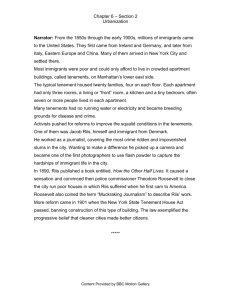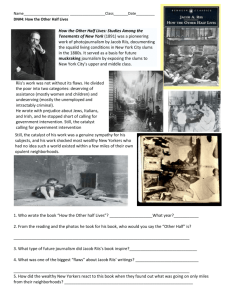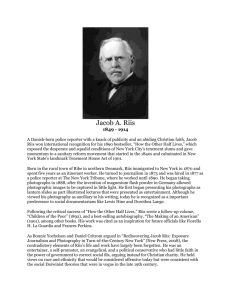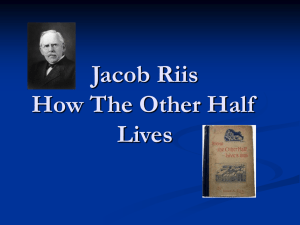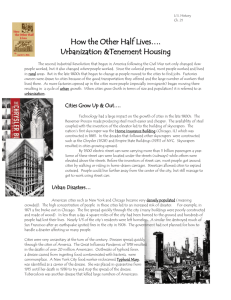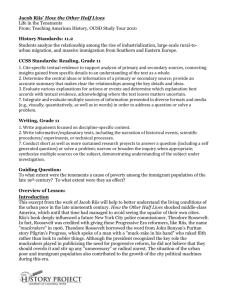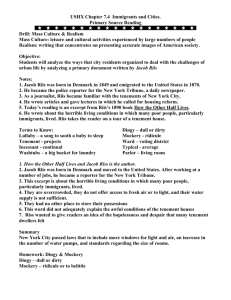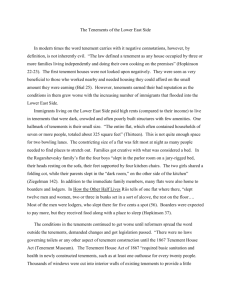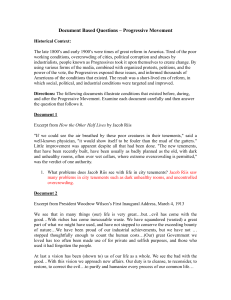Jacob Riis Photos
advertisement
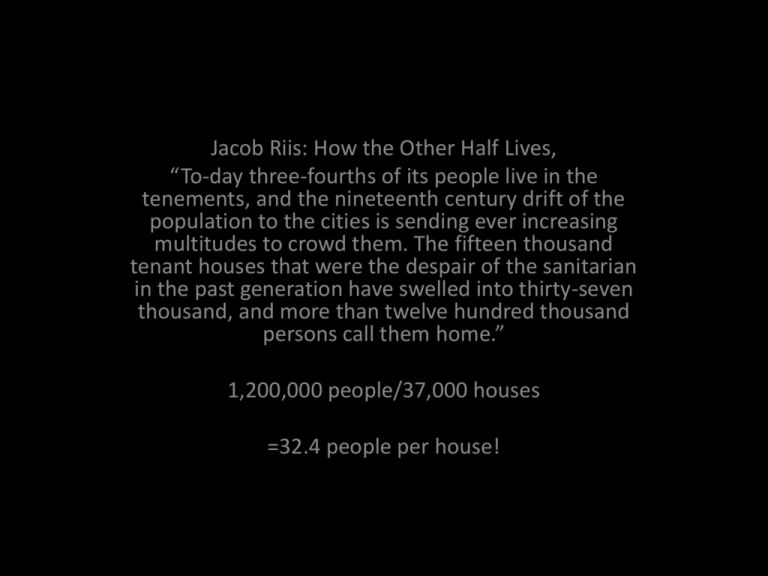
Jacob Riis: How the Other Half Lives, “To-day three-fourths of its people live in the tenements, and the nineteenth century drift of the population to the cities is sending ever increasing multitudes to crowd them. The fifteen thousand tenant houses that were the despair of the sanitarian in the past generation have swelled into thirty-seven thousand, and more than twelve hundred thousand persons call them home.” ` 1,200,000 people/37,000 houses =32.4 people per house! Mulberry Bend, New York Dens of Death: Tenement housing A Flat in the Pauper's Barracks with All Its Furniture Summer in the Tenements . . . . What if the words ring in your ears as we grope our way up the stairs and down from floor to floor, listening to the sounds behind the closed doors--some of quarrelling, some of coarse songs, more of profanity. They are true. When the summer heats come with their suffering they have meaning more terrible than words can tell. Come over here. Step carefully over this baby--it is a baby, spite of its rags and dirt--under these iron bridges called fire-escapes, but loaded down, despite the incessant watchfulness of the firemen, with broken household goods, with wash-tubs and barrels, over which no man could climb from a fire. This gap between dingy brick-walls is the yard. That strip of smoke-colored sky up there is the heaven of these people. It Costs a Dollar a Month to Sleep in These Sheds Scene on the Roof of the Mott Street Barracks The Clothes Line There is no Monday cleaning in the tenements. It is wash-day all the week round, for a change of clothing is scarce among the poor. They are poverty's honest badge, these perennial lines of rags hung out to dry, those that are not the washerwoman's professional shingle. The true line to be drawn between pauperism and honest poverty is the clothes-line. With it begins the effort to be clean that is the first and the best evidence of a desire to be honest. This photograph shows children moving trash one wheelbarrow at a time – exposing child labor. In Poverty Gap, an English Coal-Heaver's Home Ready for Sabbath Eve in a Coal Cellar Pedlar Who Slept in the Cellar of 11 Ludlow Street Rear In Sleeping Quarters, Rivington Street Dump Men's Lodging Room in the West 47th Street Station Lodging-Houses . . . . The twenty-five cent lodging-house keeps up the pretense of a bedroom, though the head-high partition enclosing a space just large enough to hold a cot and a chair and allow the man room to pull off his clothes is the shallowest of all pretenses. The fifteen-cent bed stands boldly forth without screen in a room full of bunks with sheets as yellow and blankets as foul. At the ten-cent level the locker for the sleeper's clothes disappears. There is no longer need of it. The tramp limit is reached, and there is nothing to lock up save, on general principles, the lodger. Usually the ten- and seven-cent lodgings are different grades of the same abomination. Some sort of an apology for a bed, with mattress and blanket, represents the aristocratic purchase of the tramp who, by a lucky stroke of beggary, has exchanged the chance of an empty box or ash-barrel for shelter on the quality floor of one of these "hotels." A strip of canvas, strung between rough timbers, without covering of any kind, does for the couch of the seven-cent lodger who prefers the questionable comfort of a red-hot stove close to his elbow to the revelry of the stale-beer dive. Five cents lodging: “”The 135,595 families inhabited no fewer than 31,000 different tenements. “ Eldridge Street Police Station Lodgers In a Sweat Shop Bohemian Cigarmakers at Work in Their Tenement Bandit’s Roost These children are sleeping outdoors – huddled together for warmth. Children sleeping in Mulberry Street “Bodies of drowned children turn up right along the rivers in summer whom no one seems to know anything about. When last spring some workmen, while moving a pile of lumber on a North River pier, found under the last plank the body of a little lad crushed to death, no one had missed a boy, though his parents afterward turned up.” The Effects of Jacob Riis’ How the Other Half Lives • Riis’ work brought attention to the conditions in which poor workers and immigrants lived in New York City and other major cities across America. • The emphasis Riis put on ending child labor and improving public schools in America helped reformers like Horace Mann establish public schools and helped labor unions to end child labor. • Riis’ work inspired members of the settlement house movement, like Jane Addams, the founder of Hull House. • The 16th Amendment to the Constitution, which created a graduated income tax system was adopted when Americans became increasingly aware of the disparity between the wealthy and the very poor.
